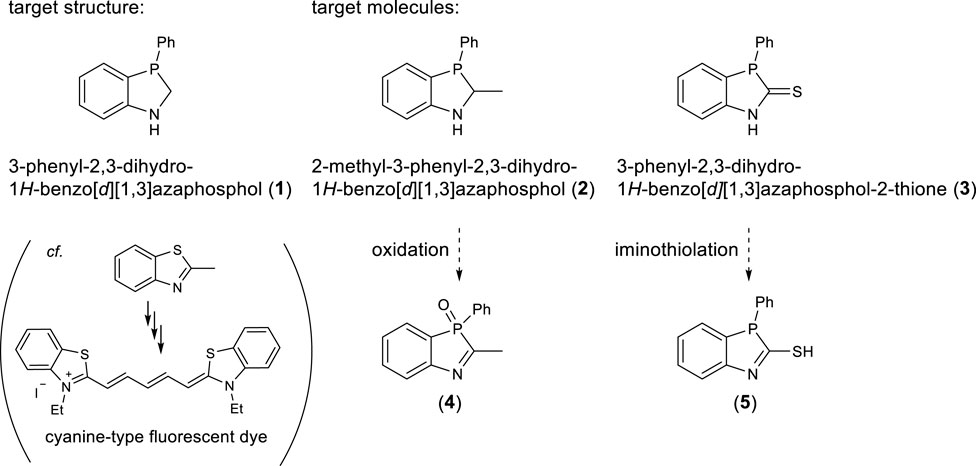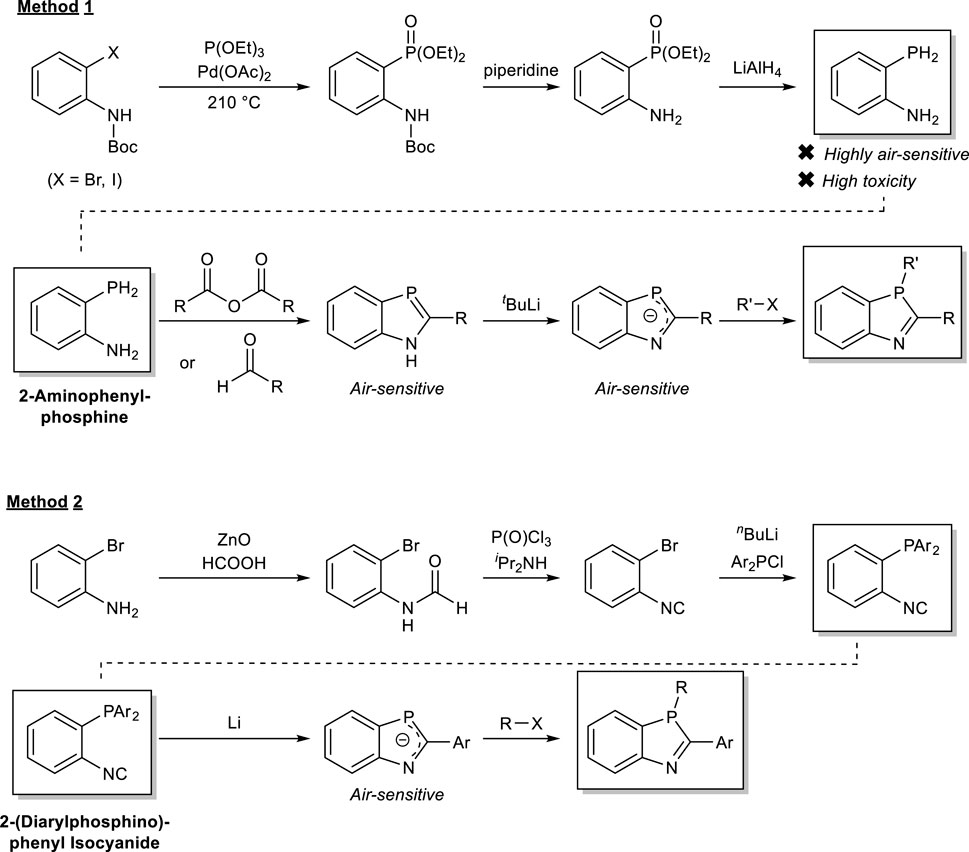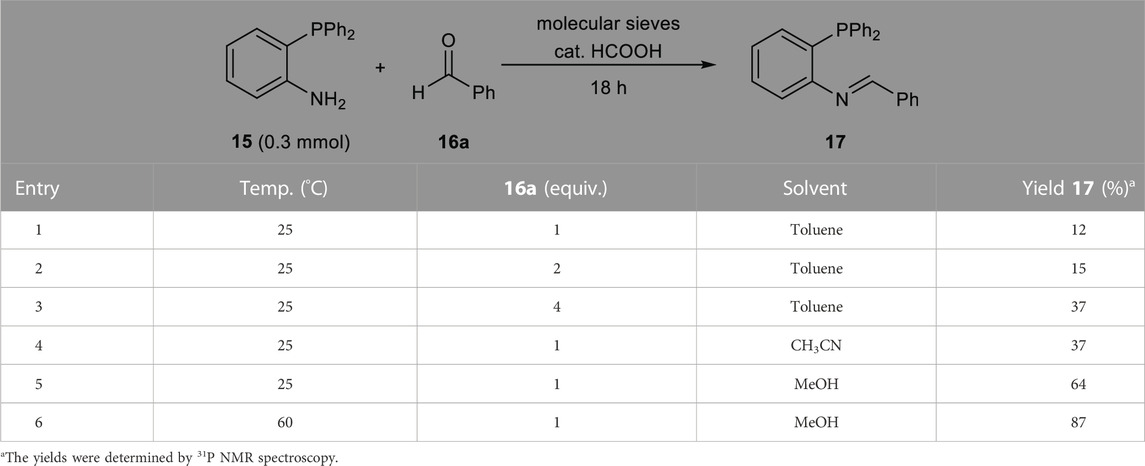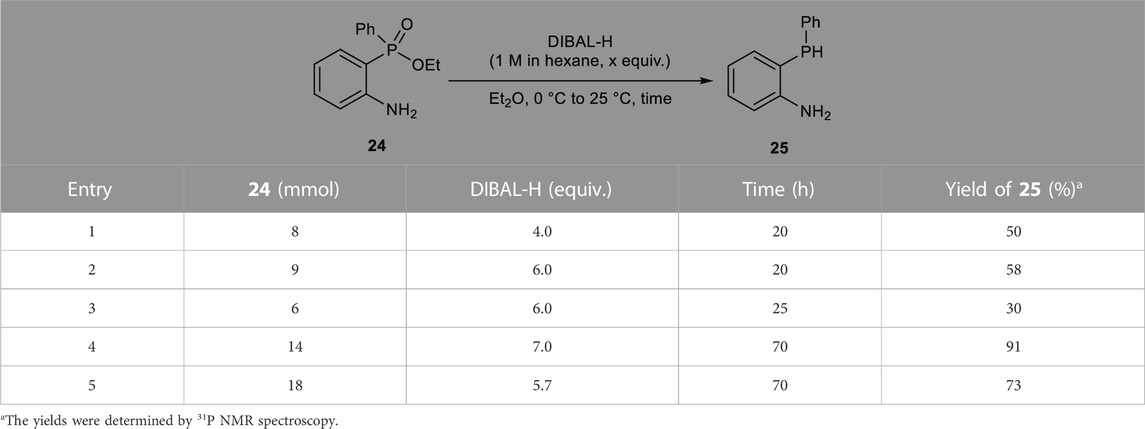- 1Department of Applied Chemistry, Graduate School of Engineering, Osaka Prefecture University, Sakai, Osaka, Japan
- 2Functional Dye Division, Hayashibara Co., Ltd., Minami-ku, Okayama, Japan
Despite the promising pharmacological activity and material properties of five-membered heterocyclic compounds containing phosphorus and nitrogen, synthetic examples of them have been rather limited due to the instability of phosphorus toward air and water. In this study, 1,3-benzoazaphosphol analogues were selected as target molecules, and various synthetic routes were examined to establish a fundamental technology for the introduction of phosphorus groups into aromatic rings and formation of five-membered rings containing phosphorus and nitrogen by cyclization. As a result, we found that 2-aminophenyl(phenyl)phosphine is an extremely promising synthetic intermediate with high stability and easy handling. Furthermore, 2-methyl-3-phenyl-2,3-dihydro-1H-benzo[d][1,3]azaphosphole and 3-phenyl-2,3-dihydro-1H-benzo[d][1,3]azaphosphole-2-thione as synthetically useful 1,3-benzoazaphosphol analogues were successfully synthesized by using 2-aminophenyl(phenyl)phosphine as a key intermediate.
1 Introduction
Furan, pyrrole, thiophene, and their saturated compounds are representative five-membered heterocyclic compounds with good stability, and numerous derivatives have been synthesized. These heterocyclic compounds are indispensable in medical and agrochemical as well as materials chemistry (Baumann, et al., 2011; Jangir, et al., 2022). In sharp contrast, five-membered ring heterocyclic compounds containing phosphorus are more unstable than O-, N-, and S-heterocycles. For example, the three bonds around the nitrogen atom of pyrrole are planar, whereas the bonds around the phosphorus atom of phosphole, in which the nitrogen atom of pyrrole is replaced by a phosphorus atom, are pyramidal (Scheme 1). As a result, phosphole exhibits very low aromaticity (Egan, et al., 1971; Epitotis, et al., 1976; Mathey, et al., 1988; Cyrañski, et al., 2002; Chesnut, et al., 2007). Because of such a structural feature, conjugated molecules involving phosphole and its analogs have recently attracted attention in the field of organic semiconductor development, including light-emitting and electronic materials (Hay, et al., 2001; Hissler, et al., 2003; Baumgartner, et al., 2004; Su, et al., 2006; Hobbs, et al., 2007; Crassous, et al., 2008; Matano, et al., 2009; Ren, et al., 2012). Despite their promising material properties, synthetic examples of five-membered ring heterocyclic compounds containing phosphorus are rather limited.
In order to take advantage of the properties of phosphorus and to realize diversity in combination with other heteroatoms, it is extremely desired to establish a fundamental technology for the formation of five-membered rings containing phosphorus. From this viewpoint, in this study, we have studied the development of synthetic methods for the formation of five-membered heterocyclic rings containing phosphorus and nitrogen. In particular, we selected 3-phenyl-2,3-dihydro-1H-benzo[d][1,3]azaphosphole 1 as a target structure and specifically investigated the synthesis of 2-methyl-3-phenyl-2,3-dihydro-1H-benzo[d][1,3]azaphosphole 2 and 3-phenyl-2,3-dihydro-1H-benzo[d][1,3]azaphosphole-2-thione 3 in detail, that have never been synthesized before. Since 2-methylbenzothiazole, in which the PhP group of 2 is replaced with S, can be derived into a cyanine-type fluorescent dye using the methyl group at the 2-position as a clue, 2 might be a key intermediate for cyanine-type luminescent dyes bearing a 1,3-azaphosphole unit. In addition, 3 is expected to lead to an azaphosphole having a thiol group at the 2-position by iminothiolation and might cause bond-connection through sulfur (Scheme 2).
2 Materials and methods
2.1 Synthesis of ethyl (2-aminophenyl)(phenyl)phosphinate via Pd-catalyzed cross-coupling reaction
2-Bromoaniline 6a (18 mmol, 3096.5 mg), ethyl phenylphosphinate 23 (17 mmol, 2892.6 mg), Pd(OAc)2 (2 mol%, 76.3 mg), dppf (2.2 mol%, 207.3 mg), iPr2NEt (22.4 mmol, 3.8 mL), degassed DMF (72 mL), and dehydrated ethylene glycol dimethyl ether (8 mL) were added to a 300-mL three-neck round-bottom flask under an argon atmosphere, and the solution was heated at 115°C for 24 h. After the reaction, the solvents were removed under reduced pressure. AcOMe (50 mL) was added to the residue, and the organic layer was washed with saturated NaHCO3 aq. (30 mL×2). The water layer was extracted with AcOMe (40 mL×3), and the combined organic layer was washed with brine (30 mL), dried with anhydrous Na2SO4, and filtered. The filtrate was concentrated under reduced pressure, and the residue was purified by silica-gel column chromatography (eluent: iso-hexane/AcOMe = 7 : 3 with 5% Et3N) to obtain pure ethyl (2-aminophenyl)(phenyl)phosphinate 24 as brown oil in 62% isolated yield (Eq. 11).
Ethyl (2-aminophenyl)(phenyl)phosphinate (24) [CAS no. 93383–23-4] (Kyba, et al., 1984). Brown oil, 2741.9 mg, 62%; 1H NMR (400 MHz, CDCl3): δ 7.85–7.75 (m, 2H), 7.43–7.29 (m, 4H), 7.14 (t, J = 8.0 Hz, 1H), 6.55–6.64 (m, 2H), 5.57 (bs, 2H), 4.18–4.00 (m, 2H), 1.31 (t, J = 7.0 Hz, 3H); 13C{1H} NMR (100 MHz, CDCl3): δ 161.9, 151.5 (d,
2.2 Reduction of ethyl (2-aminophenyl)(phenyl)phosphinate with DIBAL-H
Ethyl (2-aminophenyl)(phenyl)phosphinate 24 (14 mmol) dissolved in dehydrated Et2O (15 mL) was transferred to a 500-mL three-neck flask, and DIBAL-H (1.0 M in hexane, 7.0 equiv.) was slowly added to the reaction mixture at 0°C for 2 h, and the reaction mixture was stirred at 25°C for 70 h. After the reaction, K2HPO4 aq. (0.5 M, 140 mL) was slowly added to the reaction vessel at 0°C for 1 h. The mixture was extracted with Et2O (50 mL×5), and the combined organic layer was washed with brine (40 mL), dried with anhydrous MgSO4, and filtered. The filtrate was concentrated under reduced pressure, and the residue was purified by silica-gel column chromatography (eluent: iso-hexane/AcOMe = 9 : 1 with 5% Et3N) to obtain 2-(phenylphosphanyl)aniline (25) in 91% 31P NMR yield. Since the highly concentrated 25 could be potentially oxidized with air, the obtained 25 was stored under an argon atmosphere and directly used for the following reactions without any further purification (Table 2).
2-(Phenylphosphanyl)aniline (25) [CAS no. 67405–21-4] (Bennett et al., 2006). Pale yellow oil. 1H NMR (400 MHz, CDCl3): δ 7.45–7.36 (m, 3H), 7.30–7.22 (m, 3H), 7.21–7.16 (m, 1H), 6.77–6.70 (m, 1H), 6.68–6.61 (m, 1H), 5.11 (d, JP–H = 222 Hz, 1H), 3.89 (bs, 2H); 13C{1H} NMR (100 MHz, CDCl3): δ 149.5 (d,
2.3 Synthesis of 2-methyl-3-phenyl-2,3-dihydro-1H-benzo[d][1,3]azaphosphole
2-(Phenylphosphanyl)aniline 25 (1.0 mmol), acetaldehyde (1.5 mmol, 90 wt% aq.), 4A MS (100 mg), and degassed toluene (1 mL) were placed in a 10-mL Schlenk tube, and the mixture was refluxed at 120°C for 48 h. After the reaction, the resulting solution was filtered, and the filtrate was concentrated under reduced pressure. Finally, the residue was purified by gel permeation chromatography (eluent: CH2Cl2) to obtain 2-methyl-3-phenyl-2,3-dihydro-1H-benzo[d][1,3]azaphosphole (2) in 82% 31P NMR yield (anti/syn = 49/51) (Eq. 14).
2-Methyl-3-phenyl-2,3-dihydro-1H-benzo[d][1,3]azaphosphole (2).
(Anti-isomer) Light yellow oil; 1H NMR (400 MHz, CDCl3): δ 7.46–7.42 (m, 1H), 7.34–7.20 (m, 4H), 7.16–7.10 (m, 2H), 6.83–6.75 (m, 2H), 4.40–3.90 (m, 2H), 1.14–1.07 (m, 3H); 13C{1H} NMR (100 MHz, CDCl3) δ 155.7, 133.7 (d,
(Syn-isomer) Pale yellow oil. 1H NMR (400 MHz, CDCl3): δ 7.52–7.46 (m, 1H), 7.30–7.20 (m, 6H), 6.83–6.74 (m, 2H), 4.07 (bs, 1H), 3.90–3.83 (m, 1H), 1.42–1.34 (m, 3H); 13C{1H} NMR (100 MHz, CDCl3): δ 153.9, 139.0 (d,
2.4 Synthesis of 3-phenyl-1,3-dihydro-2H-benzo[d][1,3]azaphosphole-2-thione
2-(Phenylphosphanyl)aniline 25 (1.5 mmol), 1,1′-thiocarbonyldiimidazole (1.5 mmol), and degassed THF (5 mL) were placed in a 10-mL Schlenk tube, and the mixture was heated at 80°C for 48 h. After the reaction was completed, the solvent was removed under reduced pressure, and the residue was purified by gel permeation chromatography (eluent: CH2Cl2) to obtain 3-phenyl-1,3-dihydro-2H-benzo[d][1,3]azaphosphole-2-thione (3) in 97% 31P NMR yield (Eq. 18).
3-Phenyl-1,3-dihydro-2H-benzo[d][1,3]azaphosphole-2-thione (3). Yellow solid; 1H NMR (400 MHz, CDCl3): δ 11.2 (bs, 1H), 7.50–7.44 (m, 3H), 7.40–7.30 (m, 4H), 7.24–7.18 (m, 1H), 7.13 (d, J = 8 Hz, 1H); 13C{1H} NMR (100 MHz, CDCl3): δ 213.7 (d,
3 Results and discussion
Five-membered ring heterocyclic compounds with phosphorus and nitrogen have been largely limited in their synthetic routes compared to other five-membered ring heterocyclic compounds incorporating nitrogen, oxygen, or sulfur due to the instability of the trivalent phosphorus functional groups with air and water, the toxicity of the phosphorus–hydrogen compounds as synthetic intermediates, and the difficulty in handling the key intermediates for such phosphorus–nitrogen heterocycles. Therefore, the use of five-membered ring heterocyclic compounds with phosphorus and nitrogen in materials chemistry has been significantly restricted. Thus, the development of versatile synthetic methods is strongly desired. As to 1,3-benzophospholes, for example, only two methods have mainly been used for their synthesis (Scheme 3).
Method 1 mainly uses a route with the key intermediate 2-aminophenylphosphine, which is highly oxidizable and highly toxic. Although this route gives high yields for each step, except the final alkylation (∼60%), it requires hazardous purification of 2-aminophenylphosphine by distillation and use of a pyrophoric base (tBuLi). Unfortunately, the substituent on the phosphorus atom is limited to an alkyl group (Issleib, et al., 1978; Walborsky, et al., 1978; Issleib, et al., 1981; Heinicke, et al., 1982; Heinicke, 1986; Rösch, et al., 1987; Heinicke, 1989; Bansal, et al., 1999; Niaz, et al., 2013; Niaz, et al., 2013). Method 2 involves the synthesis of P-substituted 2-aryl-1,3-benzazaphospholes using 2-(diarylphosphino)phenyl isocyanide as a key intermediate. In this route, the key intermediate isocyanide is air-stable, but suffers from low yields of phosphorus functionalization and cyclization (both 60%) and restriction of the 2-position of the 1,3-azaphosphole ring to an aryl group (Zhang, et al., 2015).
Since Method 1 requires toxic and air-sensitive 2-aminophenylphosphine as a key intermediate, we synthesized 1,3-azaphosphole derivatives by modifying Method 2. Treatment of 2-bromoaniline 6a with ZnO/HCOOH afforded the formation of the corresponding formamide 7 in 92% yield, which led to formation of 2-bromophenyl isocyanide 8 in 82% yield by following dehydration (Eq. 1). However, the Br–Li exchange reaction of 8 and the following phosphination with Ph2PCl required strict temperature control for inhibiting isocyanide oligomerization.
Thus, we next selected the imino group instead of the isocyano group because the imino group is not susceptible to oligomerization. Before the imination reaction, the synthesis of 2-aminophosphinic ester was examined by rearrangement of the phosphino group. Then, LiAlH4 reduction followed by imination might lead to the formation of 1,3-azaphosphole. The reaction of 2-iodoaniline 9 with phenylphosphonic dichloride 10 successfully afforded 2-iodophenylaminophosphinic ester 11 as the major product. However, the following lithiation from 11 did not proceed well (Eq. 2).
As described previously, the synthesis of arylphosphorus compounds via aryllithium intermediates requires a high level of synthesis techniques and is considered undesirable from the standpoint of versatility. Therefore, we next examined the synthesis of arylphosphorus compounds by transition-metal-catalyzed coupling reactions. A proposed synthesis pathway is shown in Eq. 3. Although PdCl2-catalyzed coupling of 2-iodoaniline 9 with phenylphosphonic dichloride 10 afforded 5% of the desired 2-aminophenyl(phenyl)phosphine oxide 12 along with its dimer 12' (35%) due to the nucleophilic attack of the amino group at the phosphine, copper(I) iodide-catalyzed coupling reaction of 2-iodoaniline 9 with diphenylphosphine 14 successfully afforded 2-aminophenyl(diphenyl)phosphine 15 in 42% yield.
Then, we next examined the imine synthesis by dehydrative condensation from 2-aminophenyl-(diphenyl)phosphine 15 and benzaldehyde 16 (Table 1). When the condensation reaction of 15 and 16a was conducted in the presence of molecular sieves at 25°C, the corresponding imine 17 was obtained in 12% yield (entry 1). Excess amounts of 16a improved the yield of 17 (37%) (entry 3). Exchanging the solvent from toluene to methanol dramatically improved the yield (entry 5), and especially, 87% of the imine 17 was obtained when the reaction was conducted at 60°C (entry 6). However, attempted cyclization of the thus formed imine 17 using Pd(OAc)2 as a catalyst failed, and 17 was recovered as a phosphine sulfide 17' (Eq 4).
Thus, we attempted the Pd(OAc)2-catalyzed cyclization using in situ-generated imine intermediate 17 (Eq. 5). The imine generation was performed using two methods. After treatment with sulfur, the corresponding 1,3-benzophosphole sulfide 18 was obtained in ca. 10% yields. However, most of the imine intermediate did not undergo the desired cyclization.
To promote cyclization by bringing palladium closer to the reaction site, we attempted to synthesize (2-bromophenylamino)methylphosphine intermediate using the three methods, as shown in Eqs. 6–8. The three methods involve in situ formation of imine intermediate, followed by the addition of P–H species to the formed N=C bond, and the desired (2-bromophenylamino)methylphosphine intermediates were obtained in good yields. After the –P(S)Ph2 group was reduced to the –PPh2 group, the cyclization was examined under the conditions of Pd(OAc)2 (10 mol%), DMF, 130°C, 12 h. Unfortunately, the desired cyclization did not occur.
Since the Pd(OAc)2-catalyzed dephenylative cyclization was difficult, we next examined the cyclization using a nitrogen radical as a key species (Eq. 9). Diphenylphosphine 14 was added to trichloroacetonitrile 21 to form an imine derivative, which was oxidized with PIDA (PhI(OAc)2) to yield an imino radical. Radical cyclization and nucleophilic substitution of one chloro group by the acetoxy group afforded 1,3-azaphosphole derivative 22 in 27% yield.
Since the aforementioned method did not achieve the construction of the 1,3-azaphosphole analogous skeleton, the known reaction was reviewed once, and the synthetic route was reconstructed (Berger et al., 2013). Phosphinic acid ester 24 is synthesized by C–P bond formation from 2-bromoaniline 6a and PhP(O) (OEt)H 23 and then reduced with lithium aluminum hydride (LiAlH4) to synthesize disubstituted phosphines 25. The synthesized phosphine 25 undergoes cyclization with acetylacetone or acetaldehyde, constructing the 1,3-azaphosphole analogous skeleton (Eq. 10).
The palladium-catalyzed coupling reaction of 2-bromoaniline 6a with PhP(O)(OEt)H 23 was examined. As shown in Eq. 11, the use of slightly excess amount of 6a successfully resulted in good yield of the coupling product 24.
As we expected, the following reduction could be conducted using LiAlH4, and 2-(phenylphosphanyl)aniline 25 was obtained in 72% yield (Eq. 12).
Surprisingly, 2-(phenylphosphanyl)aniline 25 is stable in air and can be purified by silica-gel column chromatography. Conventional synthetic methods of 1,3-benzoazaphosphole analogs require the use of reagents that are sensitive to air and moisture and highly toxic. In contrast, the use of air-stable 25 as a key synthetic intermediate provides a versatile and practical synthetic method for azaphospholes.
Phosphinic acid ester 24 could successfully be reduced using diisobutylaluminum hydride (DIBAL-H). As shown in Table 2, using excess DIBAL-H and prolonging the reaction time to 70 h dramatically improved the conversion of 24, and 25 was obtained in up to 91% yield (entry 4).
The synthesized phosphine 25 was then allowed to react with acetylacetone in the presence of a catalytic amount of TsOH to synthesize 2; however, the desired reaction did not proceed efficiently, and compound 26 was obtained in 30% yields along with the generation of many unidentified phosphorus-containing species (Eq. 13).
In contrast, when the solution of 25 (0.4 mmol) and acetaldehyde (1.2 equiv.) in toluene was heated at 120°C for 20 h, the desired 2-methyl-3-phenyl-2,3-dihydro-1H-benzo[d][1,3]azaphosphole 2 was successfully obtained in 75% yield (anti/syn = 43/57). Prolonging the reaction time improved the yield of 2. Furthermore, a gram-scale synthesis of 2 was successfully achieved (Eq. 14).
Moreover, we investigated the reactions of 25 with a variety of sulfurizing agents to synthesize 3-phenyl-2,3-dihydro-1H-benzo[d][1,3]azaphosphole-2-thione 3, which is a synthetically interesting analogs of 2. When carbon disulfide (CS2) was used as the sulfurizing agent, (2-aminophenyl)(phenyl)phosphanecarbodithioic acid 26 was formed in 48% yield along with some unidentified phosphorus byproducts (Eq. 15).
The reaction of 25 with 1,1′-thiocarbonyldiimidazole successfully afforded (3) in 50% yield, whereas the use of O,O-di- (pyridin-2-yl) carbonothioate resulted in the formation of (3) in 29% yield (Eqs. 16 and 17).
Encouraged by these results, we next investigated the scale-up synthesis of 3 using 1,1′-thiocarbonyldiimidazole. Although increasing the amount of 1,1′-thiocarbonyldiimidazole to 3 equiv. resulted in the formation of some unidentified compounds, using 1 equiv. of 1,1′-thiocarbonyldiimidazole and prolonging the reaction time to 48 h successfully afforded the desired 3 in up to 97% yield (Eq. 18).
4 Conclusion
In this study, 1,3-benzoazaphosphole was selected as a target molecule, and various synthetic routes were investigated to establish a fundamental technology for the formation of five-membered heterocycles containing phosphorus and nitrogen through the introduction of a phosphorus functional group into the aromatic ring and the subsequent cyclization reaction. As a result, we found that 2-aminophenyl (phenyl)phosphine is an extremely promising synthetic intermediate with high stability and easy handling, and by using this air-stable phosphine as a key intermediate, we have succeeded in the practical synthesis of 3-benzoazaphosphole analogs, i.e., 2-methyl-3-phenyl-2,3-dihydro-1H-benzo[d][1,3]azaphosphole 2 and 3-phenyl-2,3-dihydro-1H-benzo[d][1,3]azaphosphole-2-thione 3, for the first time.
We strongly hope that the synthetic strategy for azaphosphole derivatives presented in this study will be a new milestone in the construction of phosphorus-containing functional heterocycles and will significantly contribute to the further utilization of phosphorus-centered heterocyclic compounds in the field of organic synthesis and materials science.
Data availability statement
The original contributions presented in the study are included in the article/Supplementary Material; further inquiries can be directed to the corresponding author.
Author contributions
Investigation: YY, SM, YS, KY, and AO; experiment: YY, SM, and YS; writing—original draft preparation: YY and AO; writing—review and editing: YY and AO; funding acquisition: YY and AO. All authors have read and agreed to the published version of the manuscript.
Funding
This work was supported by JSPS KAKENHI Grant Numbers JP22H02124 and JP22J14638, the Ministry of Education, Culture, Sports, Science, and Technology, Japan.
Acknowledgments
This work was supported by the Nanotechnology Platform Program on Nara Institute of Science and Technology (NAIST). YY thanks the Japan Society for the Promotion of Science for the Research Fellowship for Young Scientists.
Conflict of interest
Author KY was employed by Functional Dye Division, Hayashibara Co., Ltd.
The remaining authors declare that the research was conducted in the absence of any commercial or financial relationships that could be construed as a potential conflict of interest.
Publisher’s note
All claims expressed in this article are solely those of the authors and do not necessarily represent those of their affiliated organizations, or those of the publisher, the editors, and the reviewers. Any product that may be evaluated in this article, or claim that may be made by its manufacturer, is not guaranteed or endorsed by the publisher.
Supplementary material
The Supplementary Material for this article can be found online at: https://www.frontiersin.org/articles/10.3389/fchem.2023.1174895/full#supplementary-material
References
Bansal, R. K., Gupta, N., Heinicke, J., Nikonov, G. N., Saguitova, F., and Sharma, D. C. (1999). 1H-1,3-Benzazaphospholes the organometallic route and a new three-step synthesis with reductive ring closure. Synthesis 1999, 264–269. doi:10.1055/s-1999-3394
Baumann, M., Baxendale, I. R., Ley, S. V., and Nikbin, N. (2011). An overview of the key routes to the best selling 5-membered ring heterocyclic pharmaceuticals. Beilstein J. Org. Chem. 7, 442–495. doi:10.3762/bjoc.7.57
Baumgartner, T., Neumann, T., and Wirges, B. (2004). The dithieno[3,2-b:2′,3′-d]phosphole system: A novel building block for highly luminescent π-conjugated materials. Angew. Chem. Int. Ed. 43, 6197–6201. doi:10.1002/anie.200461301
Bennett, J., Doyle, R. J., Salem, G., and Willis, A. C. (2006). Synthesis of a chelating hexadentate ligand with a P3N3 donor set. Crystal and molecular structure of [OC-6-22]-[Co{(RP*,RP*RP*)-CH3C(CH2PPhC6H4NH2-2)3}](PF6)3. Dalton Trans. 38, 4614–4622. doi:10.1039/b607847h
Berger, O., Petit, C., Deal, E. L., and Montchamp, J. L. (2013). Phosphorus-carbon bond formation: Palladium-catalyzed cross-coupling of H-phosphinates and other P(O)H-containing compounds. Adv. Synth. Catal. 355, 1361–1373. doi:10.1002/adsc.201300069
Chesnut, D. B., and Quin, L. D. (2007). The important role of the phosphorus lone pair in phosphole aromaticity. Heteroat. Chem. 18, 754–758. doi:10.1002/hc.20364
Crassous, J., and Réau, R. (2008). pi-Conjugated phosphole derivatives: synthesis, optoelectronic functions and coordination chemistry. Dalton Trans. 48, 6865–6876. doi:10.1039/b810976a
Cyrañski, M. C., Krygowski, T. M., Katritzky, A. R., and Schleyer, P. R. (2002). To what extent can aromaticity Be defined uniquely? J. Org. Chem. 67, 1333–1338. doi:10.1021/jo016255s
Egan, W., Tang, R., Zon, G., and Mislow, K. (1971). Barriers to pyramidal inversion at phosphorus in phospholes, phosphindoles, and dibenzophospholes. J. Am. Chem. Soc. 93, 6205–6216. doi:10.1021/ja00752a035
Epitotis, N. D., and Cherry, W. (1976). On the aromaticity of phospholes and arsoles. J. Am. Chem. Soc. 98, 4365–4370. doi:10.1021/ja00431a003
Hay, C., Hissler, M., Fischmeister, C., Rault-Berthelot, J., Toupet, L., Nyulászi, L., et al. (2001). Phosphole-containing π-conjugated systems: From model molecules to polymer films on electrodes. Chem. Eur. J. 7, 4222–4236. doi:10.1002/1521-3765(20011001)7:19<4222::aid-chem4222>3.0.co;2-3
Heinicke, J. (1986). 1H-1,3-azaphosphole - neue phosphaaromaten. Tetrahedron Lett. 27, 5699–5702. doi:10.1016/s0040-4039(00)85304-6
Heinicke, J., and Tzschach, A. (1982). C-metallierung an phosphaaromaten - 2-lithio-1-methyl-1,3-benzazaphosphol. Tetrahedron Lett. 23, 3643–3646. doi:10.1016/s0040-4039(00)88646-3
Heinicke, J. (1989). Zur Synthese und Pyrolyse von Organoelement-benzasolderivaten des Phosphors, Arsens, Siliciums und Zinns. J. Organomet. Chem. 364, C17–C21. doi:10.1016/0022-328x(89)87152-9
Hissler, M., Dyer, P. W., and Réau, R. (2003). Linear organic π-conjugated systems featuring the heavy Group 14 and 15 elements. Coord. Chem. Rev. 244, 1–44. doi:10.1016/s0010-8545(03)00098-5
Hobbs, M. G., and Baumgartner, T. (2007). Recent developments in phosphole-containing oligo- and polythiophene materials. Eur. J. Inorg. Chem. 23, 3611–3628. doi:10.1002/chin.200744231
Issleib, K., Vollmer, R., Oehme, H., and Meyer, H. (1978). 1.3 – benzazaphosphole. Tetrahedron Lett. 19, 441–444. doi:10.1016/s0040-4039(01)91449-2
Issleib, K., and Vollmer, R. (1981). Synthese und Eigenschaften Der 1,3-Benzazaphosphole. Z Anorg. Allg. Chem. 481, 22–32. doi:10.1002/zaac.19814811004
Jangir, N., Poonam, , Dhadda, S., and Jangid, D. K. (2022). Recent advances in the synthesis of five- and six-membered heterocycles as bioactive skeleton: A concise overview. ChemistrySelect 7, e20210313. doi:10.1002/slct.202103139
Kyba, E. P., and Clubb, C. N. (1984) Unsymmetrical chelating ligands. Synthesis of 1-mercapto-2-phosphinobenzenes with a variety of substituents on the ligating sites. Inorg. Chem. 23, 4766–4768. doi:10.1021/ic00194a069
Matano, Y., and Imahori, H. (2009). Design and synthesis of phosphole-based π systems for novel organic materials. Org. Biomol. Chem. 7, 1258–1271. doi:10.1039/b819255n
Mathey, F. (1988). The organic chemistry of phospholes. Chem. Rev. 88, 429–453. doi:10.1021/cr00084a005
Niaz, B., Ghalib, M., Jones, P. G., and Heinicke, J. W. (2013a). π-Excess σ2P ligands: Synthesis of biaryl-type 1,3-benzazaphosphole hybrid ligands and formation of P^P′–M(CO)4 chelate complexes. Dalton Trans. 42, 9523–9532. doi:10.1039/c3dt50981h
Niaz, B., Iftikhar, F., Kindermann, M. K., Jones, P. G., and Heinicke, J. (2013b). Coplanar tetracyclic π-excess σ2P ligands. Eur. J. Inorg. Chem. 2013, 4220–4227. doi:10.1002/ejic.201300342
Ren, Y., and Baumgartner, T. (2012). Combining form with function – The dawn of phosphole-based functional materials. Dalton Trans. 41, 7792–7800. doi:10.1039/c2dt00024e
Rösch, W., Faklam, T., and Regitz, M. (1987) Phosphorus compounds with unusual coordination - 201 1,2,3,4- triazaphospholes by [3+2]-cycloaddition of azides to a stable phosphaalkyne. Tetrahedron 43, 3247–3256. doi:10.1016/S0040-4020(0190292-3)
Su, H-C., Fadhel, O., Yang, C-J., Cho, T-Y., Fave, C., Hissler, M., et al. (2006). Toward functional π-conjugated organophosphorus materials: Design of phosphole-based oligomers for electroluminescent devices. J. Am. Chem. Soc. 128, 983–995. doi:10.1021/ja0567182
Walborsky, H. M., and Ronman, P. (1978). .alpha. Addition and ortho metalation of phenyl isocyanide. J. Org. Chem. 43, 731–734. doi:10.1021/jo00398a046
Keywords: 1,3-benzoazaphosphole analogues, 2-aminophenyl(phenyl)phosphine, practical synthesis route, stable phosphorus key intermediate, heterocycles
Citation: Yamamoto Y, Mita S, Sato Y, Yano K and Ogawa A (2023) Practical synthesis of 1,3-benzoazaphosphole analogues. Front. Chem. 11:1174895. doi: 10.3389/fchem.2023.1174895
Received: 27 February 2023; Accepted: 03 April 2023;
Published: 25 May 2023.
Edited by:
Tieqiao Chen, Hainan University, ChinaCopyright © 2023 Yamamoto, Mita, Sato, Yano and Ogawa. This is an open-access article distributed under the terms of the Creative Commons Attribution License (CC BY). The use, distribution or reproduction in other forums is permitted, provided the original author(s) and the copyright owner(s) are credited and that the original publication in this journal is cited, in accordance with accepted academic practice. No use, distribution or reproduction is permitted which does not comply with these terms.
*Correspondence: Akiya Ogawa, b2dhd2FAb211LmFjLmpw
 Yuki Yamamoto1
Yuki Yamamoto1 Akiya Ogawa
Akiya Ogawa





















